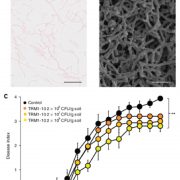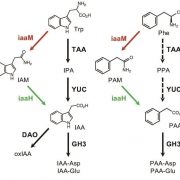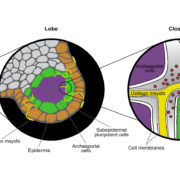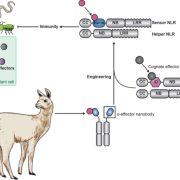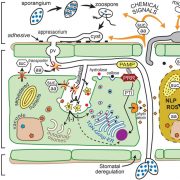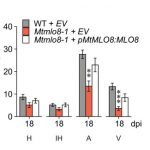Some mycoheterotrophic orchids depend on carbon from deadwood: novel evidence from a radiocarbon approach (New Phytol.)
 A mycoheterotrophic (“fungal-other-eating”) plant takes carbon nutrients from a fungus, but as fungi are not themselves photosynthetic, the (ectomycorrhizal) fungus must get its carbon from somewhere, usually a plant. Thus the typical flow of carbon goes from autotrophic photosynthesizing plant to fungus to mycoheterotrophic plant. Now, using carbon dating, Suetsugu et al. have shown that some mycoheterotrophic orchids get their carbon from (saprotrophic) fungi that get their carbon from decaying plant tissues, in this case deadwood. Although 13C carbon isotope analysis has been used previously to identify sources of photosynthetic carbon, in this case the study focused on 14C analysis to determine the age of the carbon source. As described by the authors, “The radiocarbon approach is powerful because the Δ14C values of atmospheric CO2 were globally elevated by nuclear weapons testing in the early 1950s, but have steadily declined since the nuclear test ban treaty of 1963.” The authors further discuss the use of 14C-enriched “bomb carbon” to address the nutritional mode of plants. (Summary by Mary Williams) New Phytol. 10.1111/nph.16409
A mycoheterotrophic (“fungal-other-eating”) plant takes carbon nutrients from a fungus, but as fungi are not themselves photosynthetic, the (ectomycorrhizal) fungus must get its carbon from somewhere, usually a plant. Thus the typical flow of carbon goes from autotrophic photosynthesizing plant to fungus to mycoheterotrophic plant. Now, using carbon dating, Suetsugu et al. have shown that some mycoheterotrophic orchids get their carbon from (saprotrophic) fungi that get their carbon from decaying plant tissues, in this case deadwood. Although 13C carbon isotope analysis has been used previously to identify sources of photosynthetic carbon, in this case the study focused on 14C analysis to determine the age of the carbon source. As described by the authors, “The radiocarbon approach is powerful because the Δ14C values of atmospheric CO2 were globally elevated by nuclear weapons testing in the early 1950s, but have steadily declined since the nuclear test ban treaty of 1963.” The authors further discuss the use of 14C-enriched “bomb carbon” to address the nutritional mode of plants. (Summary by Mary Williams) New Phytol. 10.1111/nph.16409
[altmetric doi=” 10.1111/nph.16409″ details=”right” float=”right”]



